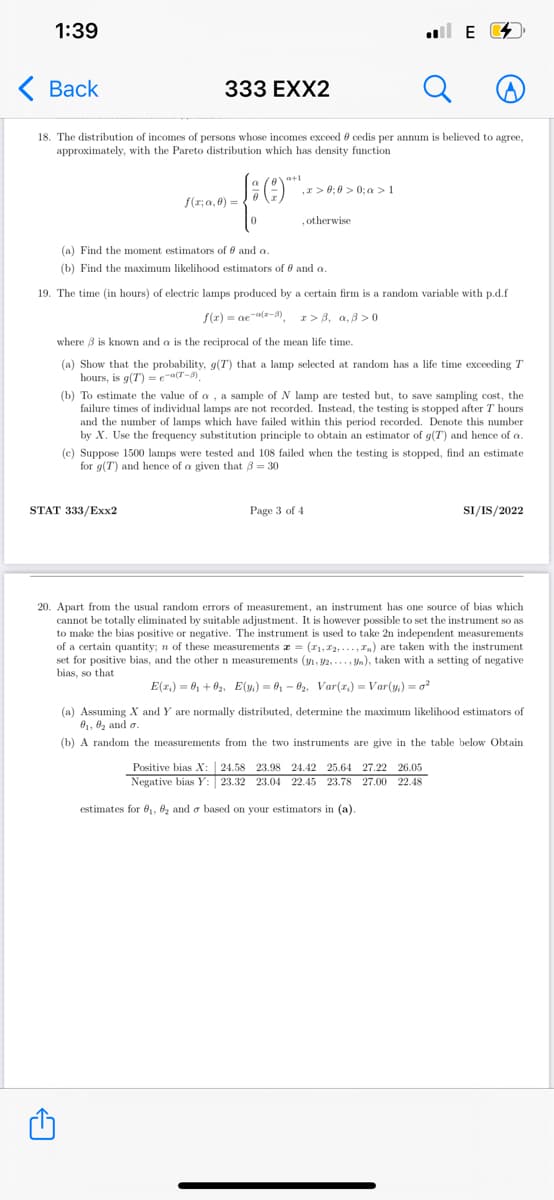18. The distribution of incomes of persons whose incomes exceed e cedis per annum is believed to agree, approximately, with the Pareto distribution which has density function EO> 0:0 > 0;a >1 f(r,a,0) = otherwise (a) Find the moment estimators of 0 and a. (b) Find the maximum likelihood estimators of @ and a. 19. The time (in hours) of electric lamps produced by a certain firm is a random variable with p.d.f f(2) = acal-9), I > B, a,3 >0
18. The distribution of incomes of persons whose incomes exceed e cedis per annum is believed to agree, approximately, with the Pareto distribution which has density function EO> 0:0 > 0;a >1 f(r,a,0) = otherwise (a) Find the moment estimators of 0 and a. (b) Find the maximum likelihood estimators of @ and a. 19. The time (in hours) of electric lamps produced by a certain firm is a random variable with p.d.f f(2) = acal-9), I > B, a,3 >0
A First Course in Probability (10th Edition)
10th Edition
ISBN:9780134753119
Author:Sheldon Ross
Publisher:Sheldon Ross
Chapter1: Combinatorial Analysis
Section: Chapter Questions
Problem 1.1P: a. How many different 7-place license plates are possible if the first 2 places are for letters and...
Related questions
Question

Transcribed Image Text:1:39
ul E 4
< Вack
333 EXX2
18. The distribution of incomes of persons whose incomes exceed e cedis per annum is believed to agree,
approximately, with the Pareto distribution which has density function
a+1
,r> 0; 0 > 0; a >1
f(r; a, 8) = .
, otherwise
(a) Find the moment estimators of 0 and a.
(b) Find the maximum likelihood estimators of 0 and a.
19. The time (in hours) of electric lamps produced by a certain firm is a random variable with p.d.f
S(2) = ae al-8)
I> 8, a,3 >0
where 3 is known and a is the reciprocal of the mean life time.
(a) Show that the probability, g(T) that a lamp selected at random has a life time exceeding T
hours, is g(T) = ea(T-9)
(b) To estimate the value of a , a sample of N lamp are tested but, to save sampling cost, the
failure times of individual lamps are not recorded. Instead, the testing is stopped after T hours
and the number of lamps which have failed within this period recorded. Denote this number
by X. Use the frequency substitution principle to obtain an estimator of g(T) and hence of a.
(c) Suppose 1500 lamps were tested and 108 failed when the testing is stopped, find an estimate
for g(T) and hence of a given that 3 = 30
STAT 333/Exx2
Page 3 of 4
SI/IS/2022
20. Apart from the usual random errors of measurement, an instrument has one source of bias which
cannot be totally eliminated by suitable adjustment. It is however possible to set the instrument so as
to make the bias positive or negative. The instrument is used to take 2n independent measurements
of a certain quantity; n of these measurements z = (r1, 12, ..., In) are taken with the instrument
set for positive bias, and the other n measurements (y, 2, ..., Ya), taken with a setting of negative
bias, so that
E(r.) = 6, +02, E(y.) = 6, - 62, Var(z,) = Var(y.) = o?
(a) Assuming X and Y are normally distributed, determine the maximum likelihood estimators of
01, 02 and o.
(b) A random the measurements from the two instruments are give in the table below Obtain
Positive bias X: 24.58 23.98 24.42 25.64 27.22 26.05
Negative bias Y: 23.32 23.04 22.45 23.78 27.00 22.48
estimates for 81, 62 and o based on your estimators in (a)
Expert Solution
This question has been solved!
Explore an expertly crafted, step-by-step solution for a thorough understanding of key concepts.
Step by step
Solved in 2 steps with 3 images

Recommended textbooks for you

A First Course in Probability (10th Edition)
Probability
ISBN:
9780134753119
Author:
Sheldon Ross
Publisher:
PEARSON


A First Course in Probability (10th Edition)
Probability
ISBN:
9780134753119
Author:
Sheldon Ross
Publisher:
PEARSON
